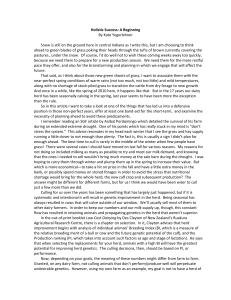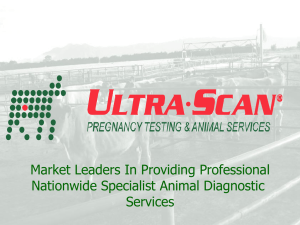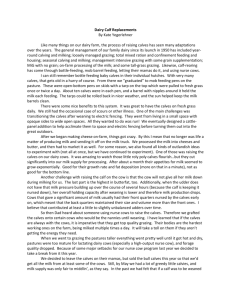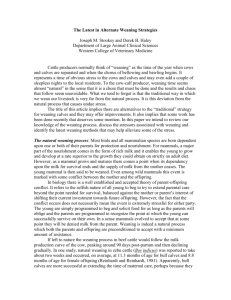“Natural” Dairying - The Swiss Connection
advertisement
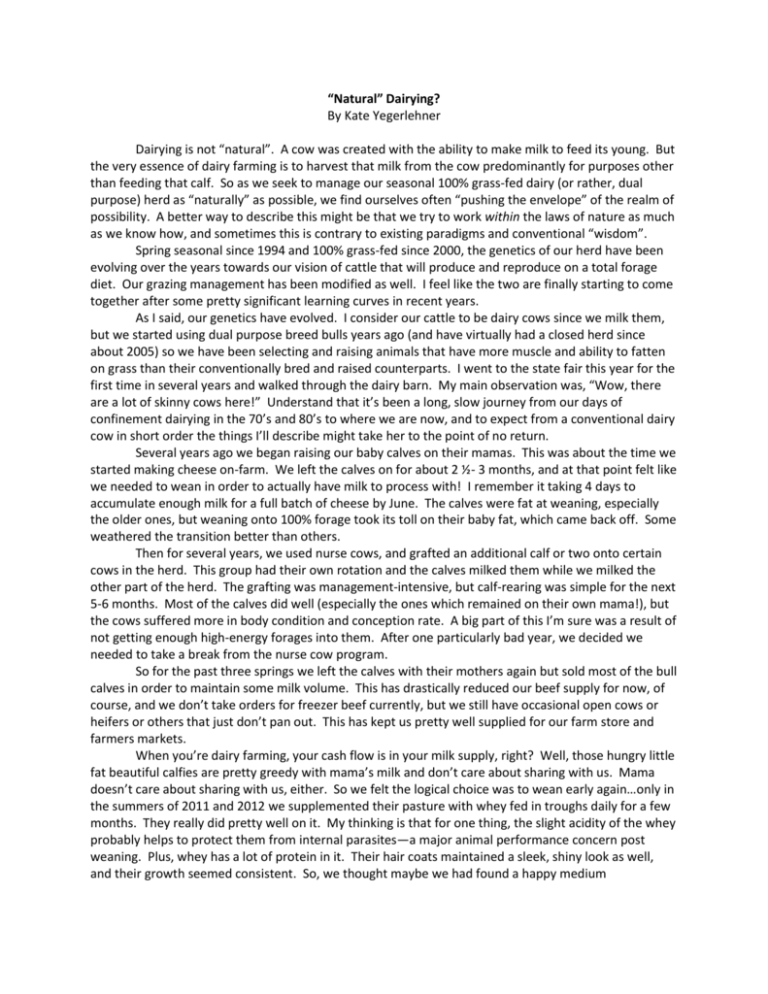
“Natural” Dairying? By Kate Yegerlehner Dairying is not “natural”. A cow was created with the ability to make milk to feed its young. But the very essence of dairy farming is to harvest that milk from the cow predominantly for purposes other than feeding that calf. So as we seek to manage our seasonal 100% grass-fed dairy (or rather, dual purpose) herd as “naturally” as possible, we find ourselves often “pushing the envelope” of the realm of possibility. A better way to describe this might be that we try to work within the laws of nature as much as we know how, and sometimes this is contrary to existing paradigms and conventional “wisdom”. Spring seasonal since 1994 and 100% grass-fed since 2000, the genetics of our herd have been evolving over the years towards our vision of cattle that will produce and reproduce on a total forage diet. Our grazing management has been modified as well. I feel like the two are finally starting to come together after some pretty significant learning curves in recent years. As I said, our genetics have evolved. I consider our cattle to be dairy cows since we milk them, but we started using dual purpose breed bulls years ago (and have virtually had a closed herd since about 2005) so we have been selecting and raising animals that have more muscle and ability to fatten on grass than their conventionally bred and raised counterparts. I went to the state fair this year for the first time in several years and walked through the dairy barn. My main observation was, “Wow, there are a lot of skinny cows here!” Understand that it’s been a long, slow journey from our days of confinement dairying in the 70’s and 80’s to where we are now, and to expect from a conventional dairy cow in short order the things I’ll describe might take her to the point of no return. Several years ago we began raising our baby calves on their mamas. This was about the time we started making cheese on-farm. We left the calves on for about 2 ½- 3 months, and at that point felt like we needed to wean in order to actually have milk to process with! I remember it taking 4 days to accumulate enough milk for a full batch of cheese by June. The calves were fat at weaning, especially the older ones, but weaning onto 100% forage took its toll on their baby fat, which came back off. Some weathered the transition better than others. Then for several years, we used nurse cows, and grafted an additional calf or two onto certain cows in the herd. This group had their own rotation and the calves milked them while we milked the other part of the herd. The grafting was management-intensive, but calf-rearing was simple for the next 5-6 months. Most of the calves did well (especially the ones which remained on their own mama!), but the cows suffered more in body condition and conception rate. A big part of this I’m sure was a result of not getting enough high-energy forages into them. After one particularly bad year, we decided we needed to take a break from the nurse cow program. So for the past three springs we left the calves with their mothers again but sold most of the bull calves in order to maintain some milk volume. This has drastically reduced our beef supply for now, of course, and we don’t take orders for freezer beef currently, but we still have occasional open cows or heifers or others that just don’t pan out. This has kept us pretty well supplied for our farm store and farmers markets. When you’re dairy farming, your cash flow is in your milk supply, right? Well, those hungry little fat beautiful calfies are pretty greedy with mama’s milk and don’t care about sharing with us. Mama doesn’t care about sharing with us, either. So we felt the logical choice was to wean early again…only in the summers of 2011 and 2012 we supplemented their pasture with whey fed in troughs daily for a few months. They really did pretty well on it. My thinking is that for one thing, the slight acidity of the whey probably helps to protect them from internal parasites—a major animal performance concern post weaning. Plus, whey has a lot of protein in it. Their hair coats maintained a sleek, shiny look as well, and their growth seemed consistent. So, we thought maybe we had found a happy medium here…calves get off to a good start on the cow, we wean about 2 ½- 3 months so we can have more milk to sell, and the calves keep growing well on the whey. Well, this summer we hosted Gearld Fry at our farm for a field day, and he gave us more to think about in terms of what we might be giving up by weaning early. He stressed the importance of getting butterfat into the calf for 10 months, in developing her body for the future, and talked about some of the shortcomings—such as a smaller heart girth—she’ll likely have without enough butterfat early in life. So I had planned to wean again onto pasture and whey in late June or early July as breeding season began, but as I write this the oldest calves are 5+ months old and still nursing. I’m milking almost 40 cows without calves on them, which is for the most part filling the demand for milk supply. There are about 25 nursing mamas. The question is, will we let the calves keep nursing through the winter? I’m not quite sure yet. What I do know is that with a little better handle on tall grass grazing with our dairy cattle, animal performance has been much better, and most of the cows nursing calves have pretty good body condition. There are a few 2-year-old first-calf heifers that have milked more fat off their backs than I would like, so it would be in their best interest to take the calf off and especially not let them nurse through the winter. Hopefully by letting calves nurse the amount of time they naturally would (I’ve read that Cody Holmes in Missouri has witnessed mama pretty effectively weaning her own calf in time for a short rest prior to the next calf’s arrival), we will begin producing animals that not only are structurally sound and healthy, but also have the ability to give plenty of high-butterfat milk to her calf and to us without sacrificing herself in the process! Being seasonal, we dry our cows off sometime between Thanksgiving and Christmas, depending on weather and grass supply. Most of the herd is moved 3 miles away to a wintering pasture (reclaimed coal mine ground that is slowly improving in fertility and soil structure through the tools of animal impact and trampled forage litter) during our semi-annual “cattle drive.” Most of the 80 acres are allowed to grow all year. This is what they graze from mid December till mid March. We try to have a little hay on hand for ice storms or deep snow periods. The young stock have been kept at home to graze for the winter in the past. If we were to let the calves nurse through the winter they will obviously go, too. This has worked well for dry cows. What I don’t know is whether the forage quality will support a lactating cow, albeit one that will probably be producing a low amount of concentrated milk at that point. One option might be to select a few of the hardiest cows with the best calves and leave them on all winter. The others could be weaned in the fall so they could go through the weaning transition on some good green grass, and their mothers could benefit from a slightly longer dry period. With one year of experience under our belts, I can be more selective in which calves I keep next spring to leave with the cow for so many months. Now, I have heard and read that at least in this neck of the woods, a grass-fed herd should optimally calve around the summer solstice. That makes for plenty of time for good gains on the cows, and if they nurse their calves through the winter then by the time the cow is ready to wean her calf, he should have plenty of green grass available to him. But again, dairying is not natural. If we waited till the summer solstice to calve, we’d be milking for maybe 6 months. Where we are located in west central Indiana, the winters can be pretty cold and sometimes snowy. It’s not always ideal for lactating cows on pasture or the people who would have to milk them in their open-air milking barn! Remember, we try to work within the laws of nature…when the grass is green and growing and lending itself to high levels of CLA and other healthy nutrients in the milk—that’s when we aim for harvesting milk to sell. When it’s cold and snowy and blowy…that’s when we try to rest more, read more, and appreciate seasonality! If we pushed the numbers, it is possible that putting up high quality stored forages to feed in December and March might bring some additional profit on the cold fringes of our current lactation season, but at what opportunity cost? That may be one of the best things about seasonal dairying…it incorporates a very intrinsic component of nature—rest!


